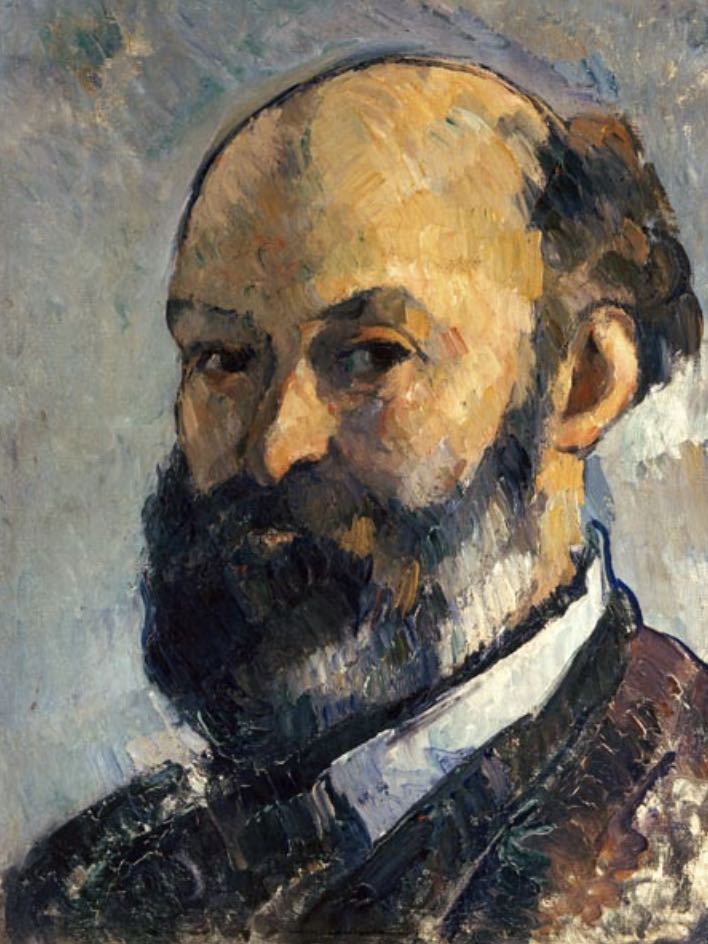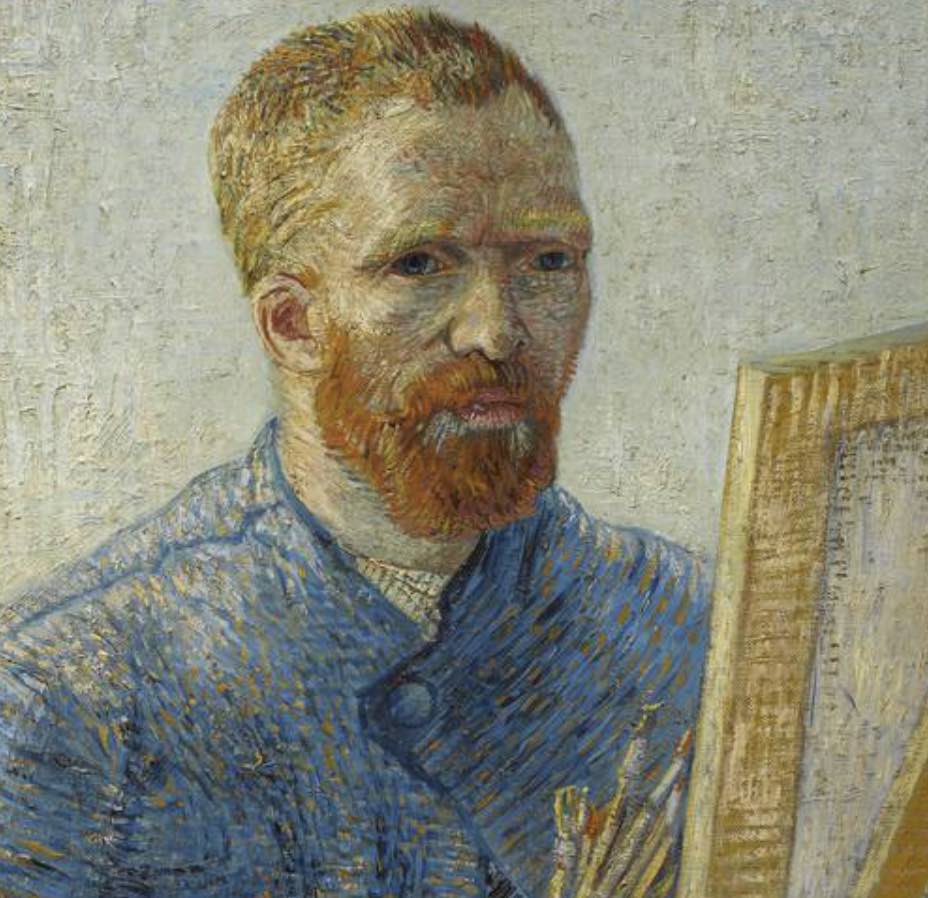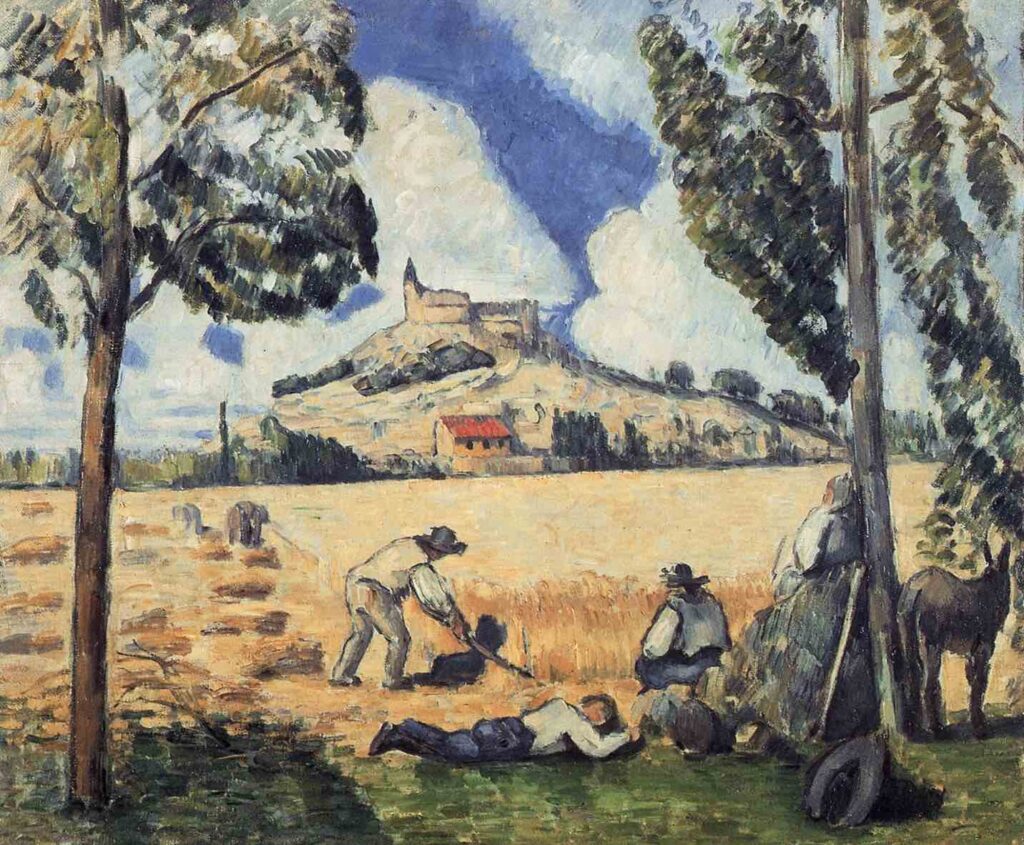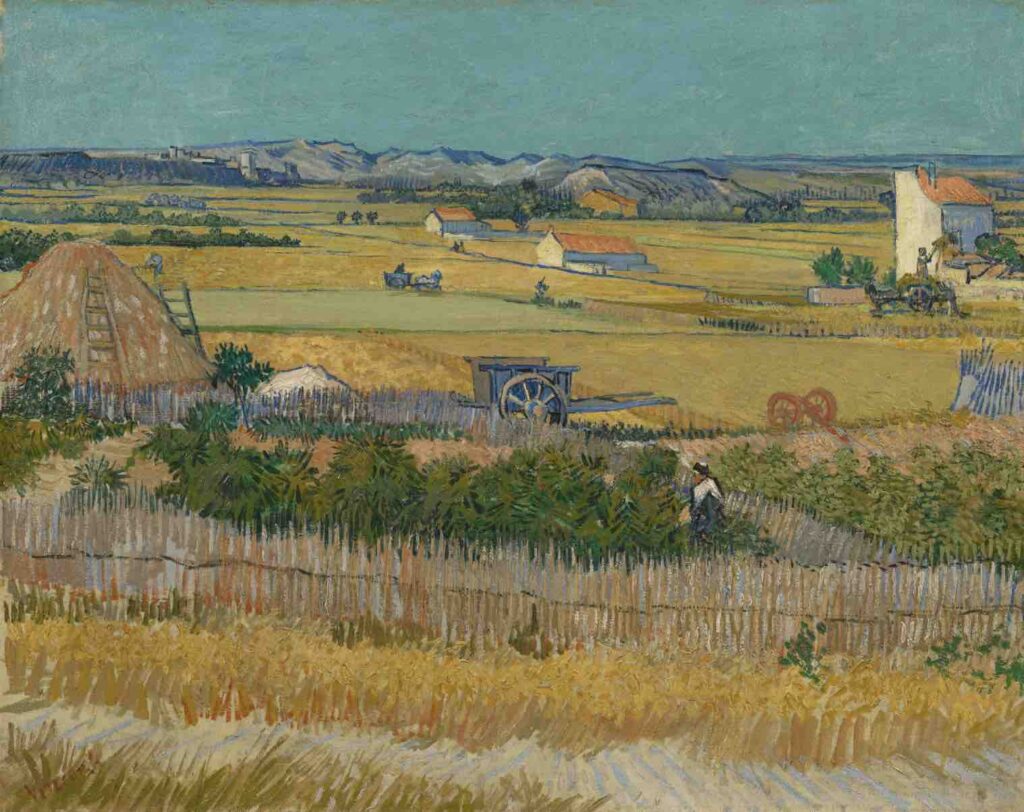The story of modern art can’t be entirely told without acknowledging the contributions of Paul Cézanne and Vincent van Gogh. Both were pioneering figures of Post-Impressionism, which saw artists exploring innovative techniques and compositions to express their emotions.
But who were these artists as individuals, and did their paths ever cross? Did Vincent Van Gogh know each other, and did they help influence each other’s art? Vincent Van Gogh and Paul Cezanne are two of the greatest artists ever. Read on as we explore their relationship[ and their artwork.
Table of Contents
- Paul Cezanne And Vincent Van Gogh – In The Heart Of Paris And Provence
- Van Gogh And Cézanne: Parallel Paths In Rock And Village Explored
- Legacy Of Two Titans – Paul Cezanne And Vincent Van Gogh
- Stylistic Juxtapositions Explored
- Frequently Asked Questions
- Related Questions
Paul Cezanne And Vincent Van Gogh – In The Heart Of Paris And Provence
Paul Cézanne and Van Gogh lived in Paris, Provence, and Auvers-sur-Oise; definitive proof of a meeting between them remains elusive. Yet, there’s no doubt that they were acquainted with each other’s oeuvre.

Their shared circles of friends included notable personalities like Emile Bernard and the art supplier Julien Tanguy, suggesting a shared world if not a shared friendship.

Bernard’s recounting of the encounter between Cézanne and Van Gogh at Tanguy’s shop paints an intriguing picture: Cézanne, ever the outspoken figure, reportedly remarked on Van Gogh’s works and said:
“Truly, you paint like a madman!”
Paul Cezanne (referring to Vincent Van Gogh’s Art)
A fascinating comment by Paul Cezanne to Van Gogh because of his approach to art. While Cézanne’s time in Paris during Van Gogh’s residence was brief, it’s plausible that he encountered the Dutch artist’s work, if not the man himself.
Cezanne And Van Gogh – Mutual Inspiration And Admiration


Van Gogh’s admiration for Cézanne’s work, especially “The Harvest” (circa 1877), is evident in his letters. This painting, which he saw in Paris, left an indelible mark on him. It wasn’t just the theme that resonated with Van Gogh but also the essence of Provence that Cézannevividly captured.
Vincent Van Gogh, in a letter to his brother Theo said:
“What I’ve seen of Cézanne involuntarily comes back to mind, because he has presented the harsh side of Provence so forcefully — as in the harvest we saw at Portier’s.”
Vincent Van Gogh To Theo Van Gogh – 13 June 1888
This connection is even more poignant considering that both artists later painted their respective versions of “The Harvest,” each infusing their style and perspective.
Cézanne, with his parallel brushstrokes and more traditional compositions, approached his subjects with a disciplined, analytical eye. His landscapes, such as the orchard blossom paintings, were admired by Van Gogh, who, in turn, painted similar subjects with his characteristic enthusiasm and intensity.
Cezanne And Van Gogh – Divergent Yet Parallel Paths
Vincent Van Gogh and PaulCezanne’s divergent yet parallel journeys can be most starkly seen in their still-life paintings of Sunflowers.
Van Gogh’s “Sunflowers” (August 1888) is a brilliant color symphony with bold strokes and almost palpable energy. Cézanne’s flower lives, while equally passionate, showcase his structured, geometric approach to nature.


While Van Gogh and Cézanne might have had different methods and motivations, their shared love for nature and the landscapes of Provence united them. Both artists broke away from the strict conventions of their time, laying the groundwork for the explosion of modern art in the 20th century.
Van Gogh And Cézanne: Parallel Paths In Rock And Village Explored
The lives of Vincent van Gogh and Paul Cézanne are riddled with intriguing parallels and almost encounters. Despite leading largely separate existences, their artistic trajectories occasionally intertwined, revealing two great minds exploring similar landscapes, both literal and metaphorical.
The Quarry Muse
In the aftermath of his tragic episode involving his ear, Van Gogh sought solace in the asylum near Saint-Rémy-de-Provence. Adjacent to this location was an ancient quarry, which served as the canvas for his inspirations on at least two occasions. The ruggedness of the quarry, with its irregular rock formations, must have resonated with Van Gogh’s tumultuous state of mind.
Half a decade later, Cézanne would paint the quarry of Bibémus, a stone’s throw away from Aix. While it’s improbable that Cézanne was familiar with Van Gogh’s quarry paintings, observing their interpretations is fascinating.
Both steered clear of realism, choosing instead to highlight the sculptural quality of the rock as if they were witnessing nature’s artwork.
Auvers-sur-Oise: A Nexus Of Their Lives
The village of Auvers-sur-Oise is another point of intersection in their narratives. After leaving Provence in 1890, Van Gogh settled in this village, which would tragically become the final chapter of his life. Contrastingly, for Cézanne, Auvers was a place of artistic evolution during 1872-74.
In Auvers, both artists fostered a deep connection with Dr. Paul Gachet. Not only was Gachet a physician, but he was also an ardent supporter of avant-garde art and a collector with an enviable stash. Within the confines of Dr. Gachet’s residence, Van Gogh was introduced to a treasure trove of Cézanne’s work.


The doctor owned more than 20 of Cézanne’s paintings, giving Van Gogh an intimate look at his contemporary’s oeuvre. Van Gogh’s admiration for Cézanne’s work is palpable in his letters, where he mentions “two fine bouquets,” referring to Cézanne’s life.
Legacy Of Two Titans – Paul Cezanne And Vincent Van Gogh
Though Van Gogh and Cézanne never forged a deep personal connection, their lives and work intersections are unmistakable. Their simultaneous gravitation towards similar landscapes and subjects reveals a shared sensitivity to the world around them.
Their affinity for the rugged landscapes of quarries or the charm of Auvers-sur-Oise underlines more profound kinship in their approach to art. Both artists were less concerned with realistic representation and more with the emotions a scene invoked.
As we reflect on their legacies, it’s poignant to imagine how their artistic journeys, though separate, seemed to echo one another, proving that great minds, indeed, think alike.
Cézanne And Van Gogh: Parallel Painters Of Provence With Diverging Strokes
The lives of Paul Cézanne and Vincent van Gogh interweaved in curious ways. Both made significant contributions to the Post-Impressionist movement, yet the interplay between them—of respect, admiration, and perhaps skepticism—remains a fascinating chapter in art history.
A Mutual Landscape, Distinct Interpretations
Both painters, in their distinct styles, captured the essence of Provence. While Cézanne’s strokes were more rhythmic and systematic, Van Gogh’s were vibrant and thick.
Vincent recognized these differences as he reflected upon the nature of their respective brushwork in a letter to Emile Bernard. He wrote:
“Knowing how much you love Cézanne, I thought these croquis of Provence might please you. Not that there are similarities between a drawing by me and by Cézanne; oh, no, no more than between Monticelli and me — but I too love the region that they have loved so much, and for the same reasons of colour, of logical design.”
Vincent Van Gogh To Emile Bernard – 20 July 1888
Despite these differences, Vincent considered Cézanne a kindred spirit, a fellow painter of the Provence countryside, albeit from different locations. Both artists, he mentioned, had to grapple with the challenges of the mistral, the strong wind that raced down the Rhône valley, making outdoor painting a formidable task.
Cézanne’s Perspective On Van Gogh
The waters become murkier when considering Cézanne’s perspective on Van Gogh. While Joachim Gasquet, the critic, mentions Cézanne’s sympathetic sentiments towards Van Gogh, Ambroise Vollard, Cézanne’s dealer, presents a starkly different narrative. According to Vollard, Cézanne had little tolerance for Van Gogh’s work.
This discordance might suggest that Cézanne’s opinions evolved or perhaps, like many artists, he held complex and multifaceted views on contemporaries. A hint of Cézanne’s latter attitude may be gleaned from his 1904 advice to Bernard, who suggests that emerging artists should carve their path, moving beyond the likes of Gauguin and “Gog.”.
Stylistic Juxtapositions Explored
Cézanne’s preoccupation with form—be it in landscapes or still lifes—is well-known. His parallel strokes, light and rhythmic, reflected a disciplined approach to deconstructing nature into its fundamental shapes.
In stark contrast, Van Gogh’s thick, impasto strokes in his mature period in France exuded raw emotion.
This divergence is prominently exhibited when they approach identical subjects. A comparison of their portraits from the same period, coincidentally housed at the Art Institute of Chicago, offers a masterclass in individualism. The compositions may echo each other, but their styles remain unmistakably personal.
Mutual Respect Amidst Differences
Regardless of their differences, it is undeniable that Van Gogh held Cézanne in high regard. They referred to him as Père (Father) Cézanne indicates a deep respect for the senior painter.
Vincent’s appreciation wasn’t limited to Cézanne’s painting style; he also admired Cézanne’s unwavering dedication to his craft. In a candid comment to Bernard, Van Gogh humorously implied that Cézanne channeled his energy into his art rather than other ephemeral pursuits.
Vincent Van Gogh, in writing to Emile Bernard, said this about Cezanne:
“Cézanne is as much a respectably married man as the old Dutchmen were. If he has a good hard-on in his work it’s because he’s not overly dissipated through riotous living.”
Vincent Van Gogh To emile Bernard – 5 August 1888
Vincent Van Gogh acknowledged to his friend Emile Bernard that Paul Cezanne was a hard worker who took his art and work very seriously.
The narrative of Cézanne and Van Gogh is not one of mentorship or profound friendship but of parallel journeys in Post-Impressionism. Both artists, with their unique styles, explored the landscapes of Provence, offering the world divergent yet equally captivating interpretations. Their relationship, filled with contrasts and convergences, remains a testament to the multifaceted tapestry of the art world.
Frequently Asked Questions
Did Paul Cézanne and Vincent van Gogh ever meet in person?
Explore the possibility of a direct encounter between these two iconic artists and how their meeting, if any, might have influenced their work.
How did the artistic styles of Cézanne and Van Gogh differ?
Delve into the distinctive characteristics of each artist’s style and technique, highlighting the unique contributions they made to the world of art.
Were Paul Cézanne and Vincent van Gogh aware of each other’s work during their lifetimes?
Examine the extent to which Cézanne and Van Gogh were familiar with each other’s artistic endeavors and whether their awareness impacted their creative processes.
Did Paul Cézanne and Vincent van Gogh share any common influences or artistic philosophies?
Explore the cultural and artistic milieu of the time to identify shared influences or philosophies that might have shaped the creative minds of Cézanne and Van Gogh.
How did the friendship between Cézanne and Émile Zola influence Cézanne’s art and, by extension, potentially impact Van Gogh?
Discuss the significance of Cézanne’s friendship with the writer Émile Zola and its potential influence on his artistic development, considering its ripple effect on Van Gogh.
What role did color play in the artworks of Paul Cézanne and Vincent van Gogh?
Explore the distinct use of color in the works of both artists, analyzing how their individual approaches to color contributed to the evolution of Post-Impressionism.
Did Paul Cézanne and Vincent van Gogh ever collaborate on any artistic projects?
Investigate whether there were any collaborative efforts or shared projects between Cézanne and Van Gogh that might have left a mark on the history of art.
How did the personal lives and struggles of Cézanne and Van Gogh influence their artistic expressions?
Examine the personal challenges and triumphs of each artist, and analyze how these factors may have been reflected in their paintings and artistic choices.
In what ways did Paul Cézanne and Vincent van Gogh contribute to the development of Post-Impressionism?
Discuss the specific innovations and contributions of both artists to the Post-Impressionist movement, highlighting the ways in which they pushed the boundaries of traditional art.
What is the legacy of Paul Cézanne and Vincent van Gogh, and how has it influenced subsequent generations of artists?
Explore the lasting impact of Cézanne and Van Gogh on the world of art, examining how their legacy continues to inspire and shape the work of contemporary artists.
Anita Louise Art is dedicated to art education, great artists, and inspiring others to find and create their art. We love art that uplifts and inspires. #ArtToMakeYouSmile! #ArtToMakeYouHappy!
If you are interested to see any of my art, you can find out more by clicking here. If you are interested in what inspires me and my paintings, you can discover more by clicking here.
We have a free newsletter and would love you to be part of our community; you can subscribe to the newsletter by clicking here. If you have any questions, I would be happy to talk to you any time. You can reach me, Anita, by clicking here.
Subscribe to our Anita Louise Art YouTube Channel filled with great videos and information by clicking here.
Related Questions
What Was The Impact Of Vincent Van Gogh On The Art World?
Van Gogh used color, form, and emotions in his art. He had a bright palette that was individualized for his time. Even though he did not see a lot of success during his life after he died, the impact of his art can be seen in both the Expressionism and Fauvism movements that were taking place in Europe.
By clicking here, you can learn more by reading What Was The Impact Of Vincent Van Gogh On The Art World?
What Was The Focus Of Renaissance Art?
The focus of Renaissance art was on the classics of Greek and Rome, humanist philosophy, and the study of the human figure. Realism was also an essential part of renaissance art. The great artists of the Renaissance also became great anatomists and studied human beings.
By clicking here, you can learn more by reading What Was The Focus Of Renaissance Art?.
Why Was Impressionism Art at First Rejected?
During the emergence of impressionism art, fine-art oil painting was an extremely important addition to the interior design of a home, especially for the affluent and the increasing arrival of the middle classes. For these art patrons, there were only some very specific styles of art that were considered acceptable for them to use for the interior design of their home and impressionism art did not fit into any of these culturally acceptable fine art categories.
To discover more you can read our blog Why Was Impressionism Art at First Rejected? by clicking here,

